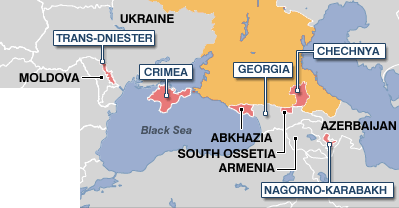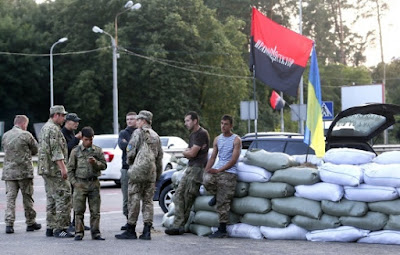![]() |
| Right Sector ultranationalists in Lviv this week |
Back in early 2014, during the Winter Olympics in Sochi, I predicted on this blog that
Crimea would be the next part of the post-Soviet “near abroad” to explode in violence between pro-Russian and anti-Russian forces. And indeed it was that republic within independent
Ukraine that the
Russian Federation invaded and annexed mere weeks later. This blog has followed the ensuing Russian war on Ukraine closely, and almost exactly a year ago (in an article in this blog titled
“Will Transcarpathia Be the Next Donetsk—or Crimea?”), I opined that Ukraine’s
Transcarpathia was a likely place for President
Vladimir Putin’s next infringement of Ukrainian sovereignty. Well, this week the Transcarpathian domino has started to fall, but not quite in the direction I had predicted.
First, some history. The
oblast (province) of Transcarpathia is a former part of the
Austro-Hungarian Empire which between the world wars was attached by the
League of Nations as the eastern “tail” of the new composite republic of
Czecho-Slovakia. Its inhabitants included, and continue to include,
Ukrainians,
Magyars (
Hungarians),
Russians, and a long-standing local minority called the
Ruthenian, or
Rusyn, people—Slavs whose communities are also found in nearby
Poland and
Slovakia today, where they tend to be known as
Lemkos. When
Adolf Hitler moved into Czechoslovakia in 1938 and 1939,
Ruthenia and
Slovakia, separately, declared independence, but Transcarpathia was annexed by the
Axis government in Hungary. After the Second World War, Transcarpathia, also called
Carpathian Ruthenia or
Carpatho-Ukraine, was grafted onto the
Ukrainian Soviet Socialist Republic under
Josef Stalin. In the centrally-governed Soviet empire, boundaries between constituent S.S.R.s had little meaning, but after the
Soviet Union dissolved in 1991, Ukraine became one of the places where, as Putin was later to put it, people went to bed as Soviet citizens and woke up as a Russian minority in a foreign country. (Imperialist karma’s a bitch, ain’t it?) Autonomy-minded residents, including some ethnic Hungarians (12% of the oblast), Russians (3%), and Ruthenians (by then less than 1%) declared an independent
Republic of Subcarpathian Rus’ in 1993, but it fizzled.
![]() |
| The flag of Transcarpathia |
In 2008, as Putin was flexing his muscles in the neighboring
Republic of Georgia—formalizing, through war, two of its constituent regions,
South Ossetia and
Abkhazia, as Russian puppet states—trouble was brewing in Ukraine as well. Again, Transcarpathians rose up, this time declaring an independent
Republic of Carpathian Ruthenia. This the government in Kyiv would not indulge, claiming that it was all being staged by Moscow—which, given the events in Georgia, remains a reasonable interpretation.
In 2012, the new ethnically Russian–Polish–Belarussian pro-Kremlin president of Ukraine,
Viktor Yanukovych, helped enshrine Russian, Ruthenian, Hungarian, and other minority languages as official. But after Yanukovych fled and was impeached in the popular “Euro-Maidan” uprising in 2014, the largely progressive, democratically-minded new government included strong elements of the Ukrainian-nationalist far right, including the fringe neo-fascist group
Right Sector (
Pravyi Sektor), who, because of their importance in the Euro-Maidan movement, were given a small political role, including some ministries. (I discussed Right Sector and kindred groups in
an article last year; see also
this article.) These right-wing elements pushed through an erasure of minority language rights—a policy which was quickly reversed, under international pressure, but remains for many non-Ukrainian-speakers a symbol of the new regime’s disdain for them and a pretext for ethnic-Russian separatism in places like Crimea and the Donbas. The cause of Transcarpathian autonomy has an ally (
as discussed earlier in this blog) in
Jobbik, the pro-Kremlin right-wing extremist nationalist group which is now Hungary’s third-largest political party. As in
Kharkiv (
see article from this blog) and
Odessa (
see article from this blog) oblasts, a pro-Kremlin “people’s republic” has been declared in Transcarpathia, but without any actual rebel control of territory as there is in the self-declared pro-Kremlin
Donetsk People’s Republic and
Luhansk People’s Republic in southeastern Ukraine.
![]() |
| Right Sector yobbos with “Wolfsangel” armbands |
Observers have long wondered now which “near abroad” territories Putin would, either directly or, as he prefers, through “false flag” battalions and agents provocateurs, try to invade next: Odessa?
Transnistria?
Transcaspia? Transcarpathia? But in Transcarpathia the spark that lit the fuse this week has come from the aforementioned ultranationalist Ukrainian group Right Sector, which has thousands of active, armed members throughout Ukraine and as many as 10,000 fighting Russian troops in the Donbas. On July 11th, according to Ukrainian prosecutors, two dozen armed militants wearing Right Sector insignia exchanged gunfire with police at a café in the Transcarpathian city of Mukachevo, destroying police and civilian cars with grenade launchers and killing two officers. Five Right Sector fighters were wounded, but most fled to a nearby rural area where police engaged them in a siege—still ongoing three days later as this is being written, with
ten Right Sector militants holding out against state police (though reliable up-to-date reports are difficult to find).
![]() |
| Will Transcarpathia join the archipelago of Russian puppet regimes? |
Russian news reports the same day
described Right Sector attacks on a gymnasium and a police station, also in Mukachevo. Two were killed at the gym, owned by a local legislator,
Mikhail Lanyo, allied with the Yanukovych regime.
![]() |
Ukrainian fascists with red-and-black flags were a minority but a high-profile presence during the Euro-Maidan movement of 2013-14. |
Some descriptions of events say the incident in the café was a meeting between rival gangs—one run by Lanyo, who controls border crossings with the
European Union (
E.U.) states of
Romania, Hungary, and Slovakia, and rivals in league with Right Sector and a local politician named
Viktor Baloha, who is reported to run Transcarpathia as his own mafia-style fief. The summit meeting, planned to divide territories in gangland-politics fashion, got out of hand, drawing in the police.
![]() |
| Viktor Baloha |
As this article goes to press, two Right Sector participants in the events have been taken to Kyiv for questioning, a six-year-old boy taken hostage by Right Sector has been released, and Right Sector volunteer troops, who seem extremely well organized, have established roadblocks on the main Kyiv–Zhytomyr road. Right Sector spokespeople also say they are working
with the Ukrainian secret police, the
S.B.U. (
Sluzhba Bezpeky Ukrayiny, or
Security Service of Ukraine), to restore order—which, if true, anyone should find a bit worrying.
![]() |
| A Right Sector roadblock in Transcarpathia this week |
The same state-owned and state-controlled Russian media outlets that the Kremlin uses as a tightly scripted propaganda machine disseminating lies about the conflict in the southeast
are describing what sounds like a near-takeover of Ukraine by Right Sector forces. Ukraine’s president, the former chocolate tycoon
Petro Poroshenko, on the other hand,
says the events are only about smuggling and not about geopolitics. Meanwhile, however, hundreds of Right Sector protestors in Kyiv are demanding the resignation of the minister of the interior,
Arsen Avakov. In Ukraine’s second city, Lviv (the Ruthenian capital in the days of the
Habsburgs), according to Russian media, Right Sector demonstrators
lowered E.U. flags at the main administrative building and replaced them with their own ultranationalist red-and-black flags. And Right Sector demonstrations are being reported in cities as far apart as Kharkiv in the east and Ternopil in the west.
![]() |
| Right Sector on parade |
In a reshuffle reminiscent of the decision earlier this year to install the former Georgian president,
Mikheil Saakashvili, as governor of the ethnopolitically tense Odessa oblast, Poroshenko’s administration
today namedHennady Moskal, the chairman of Luhansk oblast’s State Military and Civil Administration, to be Transcarpathia’s new governor. In both cases, Poroshenko seems interested in shoring up Ukraine’s geopolitically vulnerable regions by putting them in the charge of politicians that have direct experience with surrendering to Russia. Moskal
supports Poroshenko’s position on the conflict, saying that Transcarpathia is a “green channel” through which billions of dollars’ worth of commodities, including timber but mostly Belarussian cigarettes,
are smuggled into the E.U. via light planes, drones, and tunnel systems, as well as co-opted border controls.
![]() |
| The Euro-Maidan movement was—sometimes unfortunately so—a big tent. |
One possible cause of the rise of Right Sector at this particular juncture is popular Ukrainian dissatisfaction with Poroshenko’s handling of the ongoing undeclared war with Russia. The government has all but written off Crimea as lost and seems willing to accept Putin’s demand that Ukraine turn the 24 out of 27 oblasts it still controls from a unitary state (as the constitution designates it) into a loose confederation—which is rightly seen as a euphemism for allowing ethnic-Russian-dominated areas to be hived off as Russian puppet states. Even the E.U. is urging Poroshenko to throw in the towel and allow “federalism.” (Interestingly, Putin has no appetite for autonomy or federalism within the Russian Federation itself, which he rules from the center with an iron fist.)
![]() |
| Putin preparing to ride westward across the Steppes |
As in Crimea, Donetsk, and Luhansk—and as in Odessa, where a deadly arson fire last year that killed pro-Russian demonstrators stoked anti-Kyiv feeling—one must be especially on guard when local events seem to provide a perfect pretext for Russian intervention. As one Ukrainian political analyst,
Petro Kralyuk,
puts it, Russia’s
Federal Security Service (
F.S.B., successor to the
K.G.B.) “has successfully picked up the baton. For Russia, Transcarpathia and its surroundings remain an important region. Taking into account the blurred identity and ethnic diversity of the local population, the field of activities for these agents is quite fertile.” Kralyuk calls this week’s apparent rise of Right Sector violence “a wonderful gift” for Moscow. If events follow the earlier scripts, Putin will now say that neo-Nazis (Right Sector) are taking over Ukraine and that it is time to help the poor ethnic Russians, Hungarians, and Ruthenians in Transcarpathia “liberate” themselves from Kyiv’s tyrrany, just like Crimea, Donetsk, and Luhansk. With Russian help, of course. Out of the goodness of Putin’s heart. You read it here first.
[You can read more about Transcarpathia, Donetsk, Luhansk, Crimea, Transnistria, and many other separatist and new-nation movements, both famous and obscure, in my new book, a sort of encyclopedic atlas just published by Litwin Books under the title Let’s Split! A Complete Guide to Separatist Movements and Aspirant Nations, from Abkhazia to Zanzibar. The book, which contains 46 maps and 554 flags (or, more accurately, 554 flag images), is available for order now on Amazon. Meanwhile, please “like” the book (even if you haven’t read it yet) on Facebook and see this interview for more information on the book.]













